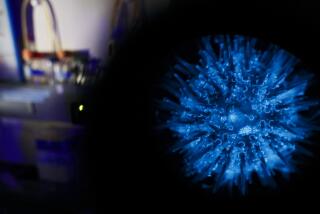A Prickly Question
- Share via
Sea urchins are one of the stranger animals around. I know a bit about them because for several years I made my living harvesting urchins. Peculiar, round-shelled and sharp-spined, they seem more like marine cacti than animals, and most people are surprised to find that anyone would harvest them for any reason at all. Usually, people think about sea urchins only when, while swimming or diving, they step on one and a spine pierces a vulnerable body part. So why would anyone gather the things? To clear away an underwater hazard, perhaps?
To make lots of money. Inside the large, purplish urchins ( Strongylocentrotus franciscanus ) are either yellow or orange sacs--called roe--that are a delicacy highly prized by the Japanese. Southern California weather permitting, divers go out daily in small boats and, using implements much like garden rakes, scrape thousands of pounds of urchins off reefs and into hand-held nets. These nets are hoisted aboard and then carried back to port (loads on a 30-foot boat can exceed five tons).
Once in port, the urchins are winched onto trucks that transport them to small factories in Oxnard and Los Angeles, where they are “processed.” Were one a sea urchin, to be processed would mean to have one’s shell chopped open so that one’s roe could be gently lifted out and laid in small trays. These trays would be trucked to the airport and then flown to Japan, where the roe would be consumed fresh at extremely high prices. During the past several years, Southern California divers have harvested an annual average of 18 million pounds of sea urchins, mainly from around the Channel Islands. Most of this roe is exported, but a domestic market is growing.
According to California Department of Fish and Game marine biologist Dave Parker, labeling the sacs roe is imprecise; they are not fish eggs. Although the sacs do perform a sexual function--the male’s bright yellow sac contains sperm, and the female’s orange sac eggs--they also store reserves of nutrients. Because the sperm and eggs are hardy and large (and can be seen with a low-power microscope), they are used to study cell fertilization, splitting and development. Urchin reproduction is part of the curriculum at many schools and colleges. Also, the ease with which an urchin’s private parts can be collected makes it our friend in cancer research. Scientists use urchin cells to examine cell division in order to experiment with substances that can inhibit that division; if a something could be found that would inhibit the growth of a specific kind of cell, perhaps a cancer could be stopped.
Developmental biologists use urchin cells to study the mechanisms by which cells are directed to perform certain functions, to find out why some cells become part of the urchin’s shell and others part of its sac. The better that researchers understand these processes, the further along they will be toward understanding them when they are abnormal--that is, cancerous.
All right, so urchins are important, and they meet the dictionary definition of animal --different from plants by certain typical characteristics such as the power of locomotion, fixed structure and limited growth and nonphotosynthetic metabolism. But science aside, is a sea urchin really an animal?
With all due respect to Carl von Linne (1707-1778), the hard-working Swedish botanist who invented the system of taxonomy (the classifying of living things) and who spent much of his life renaming every known living thing in Latin (including himself; he became Carolus Linnaeus), a sea urchin doesn’t meet my personal definition of animal : that is, a cute, pettable, four-legged creature with tongue and cold nose. A pet.
A sea urchin possesses not one of those characteristics, though it approximates several: It is somewhat mobile, having thousands of suckers that it can extend like thin, elastic straws and by means of which it can either slowly move or tenaciously cling. Too, if not a tongue, it at least has a mouth. Kind of. Its mouth is an eerie, five-section trapdoor, called Aristotle’s lantern, located on its bottom. And there are people around here who keep urchins--the smaller species, anyway--as pets in their home saltwater aquariums, although one would have to live near a beach in order to maintain a supply of kelp, the sea urchin’s main source of food.
But to me, they remain a form of marine cactus. An animal is a living thing that addresses the human need for affection; it is something warm and snuggly. A koala bear is an animal. A sea otter is an animal. Kathleen Turner is an animal.
Sea urchins are not animals; the distinction is purely emotional, Carolus Linnaeus notwithstanding.






